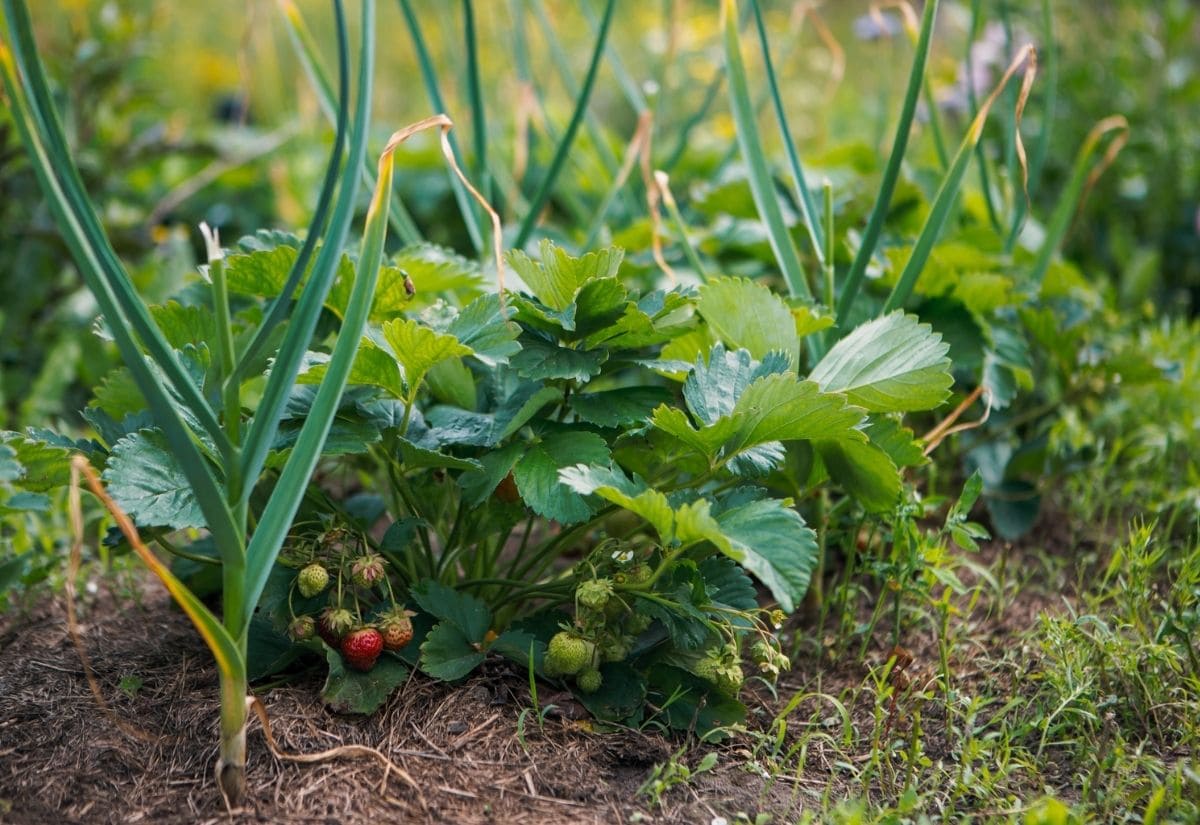
Strawberries are listed at the top of the “Dirty Dozen” as the produce that is most contaminated with pesticides. We don’t want these nasty chemicals in our gardens, and the best way to grow strawberries naturally is with companion planting.
Companion planting is the practice of growing other plants in your garden that will benefit your strawberries by deterring bad bugs, attracting good bugs, reducing disease, protecting the crop and the soil, and adding beautiful diversity to your strawberry patch.
Whether your strawberry plants are cozy in a greenhouse, thriving in containers, or living it up in your veggie garden, pairing them with plants that thrive alongside strawberries can help control pests, boost yields, improve soil health, improve pollination, and even enhance the flavor of the strawberries.
There are many different crops, herbs, and flowers that get along well with them and make excellent companion plants for strawberries.
You can Interplant strawberries with vegetables like legumes, alliums, root vegetables, asparagus, rhubarb, and leafy greens. Herbs such as basil, mint, and dill also make excellent strawberry companions! And let’s not forget flowering friends like sunflowers, clover, borage, and marigolds that play a vital role when planted in close proximity to strawberries.
However, not all plants make good neighbors for your strawberries. Be cautious with nightshades, brassicas, roses, corn, fennel, chrysanthemums, kohlrabi, and okra, as they can be detrimental to your strawberries.
Let’s learn about the best companion plants for strawberries and what you should avoid planting next to strawberries.
Benefits Of Companion Plants For Strawberries
Nature’s way of maintaining biodiversity can be observed in the way various species grow symbiotically together. As you watch a sea of grass waving in the wind or a large pine forest standing the test of time, what looks like thousands of the same plant is actually a vast conglomeration of different species growing symbiotically together.
Monocropping is one of the most devastating and destructive practices of modern agriculture. By only planting one crop in a large field, farmers have opened their land up to diseases, insects, and the elements: problems that easily take hold of one crop that would otherwise be thwarted by different species.
The same thing can happen in our gardens. If we have a huge strawberry patch (and why not since these berries are so delicious), we are setting ourselves up for problems. But we can grow other plants in our patch that would benefit, protect, and shelter our strawberries.
This is the essence of companion cropping for our strawberries. Opting for a diverse cultivation approach rather than a single-species strawberry monoculture is a more advantageous strategy. Fortunately, with strawberries, this is simple to achieve as numerous plants coexist harmoniously alongside them.
Why Companion Plants Are Important When Growing Strawberries
Strawberries respond very well to companion plants as these soft fruits are easily affected by neighboring plants.
Companion plants can have a number of benefits for our strawberries, such as:
When deciding which strawberry companion plant to grow, remember that some of the plants listed below might grow well with strawberries but won’t grow with each other. Check out this list to make sure your companion plants are all copacetic.
Every vegetable, flower, and herb that you grow will benefit your strawberries in different ways. Here are the best companion plants to grow in your strawberry patch:
Vegetable Companion Plants For Strawberries
Growing other vegetables with our strawberries is sometimes called intercropping or succession planting, because not only will the other vegetables benefit the strawberries, but they can give you a second crop as well.
Here are the most beneficial vegetables to grow with strawberries:
1: Beans

Benefits: Nitrogen Fixation
Beans are a legume, and as such, they have the capability of taking nitrogen from the atmosphere and adding it to the soil, through a process called nitrogen fixation. The large seeds make them easy to direct seeds around your strawberry plants to maximize space.
How To Grow As A Companion: Beans come in bush and pole (vining) varieties. Choose the variety that works for you and interplant them amongst your strawberries, or they can be grown in rows beside. You want the mature plants to be at least 15cm (6 inches) apart.
Make sure bush varieties are not too close to the strawberries or the dense bushes may smother the low growing berries. Position trellises of pole beans to not block too much light, but to provide afternoon shade if needed.
2: Peas

Benefits: Nitrogen Fixation
Like beans, peas will improve the soil by fixing nitrogen. Peas are vining plants that love to climb, so even if you have a compact variety that doesn’t require staking, some support would be beneficial to keep the peas from vining around the strawberries.
How To Grow As A Companion: Peas are one of the earliest vegetables you can grow, so you can plant them around your strawberries. With constant picking, most varieties will produce all summer long.
3: Onions

Benefit: Pest Repellent
Onions repel a variety of insects like snails and fungal spores and animals including aphids, flies, beetles, rabbits, squirrels, gophers, and even deer. Their natural stench keeps these unwanted pests away from your strawberries.
How To Grow As A Companion: Start onion sets directly in the garden as early as you can in the spring. Make sure you leave enough space between the onions and the bulbs depending on the variety you are growing to allow them to reach full size without interfering with each other.
4: Scallions (Green Onions)
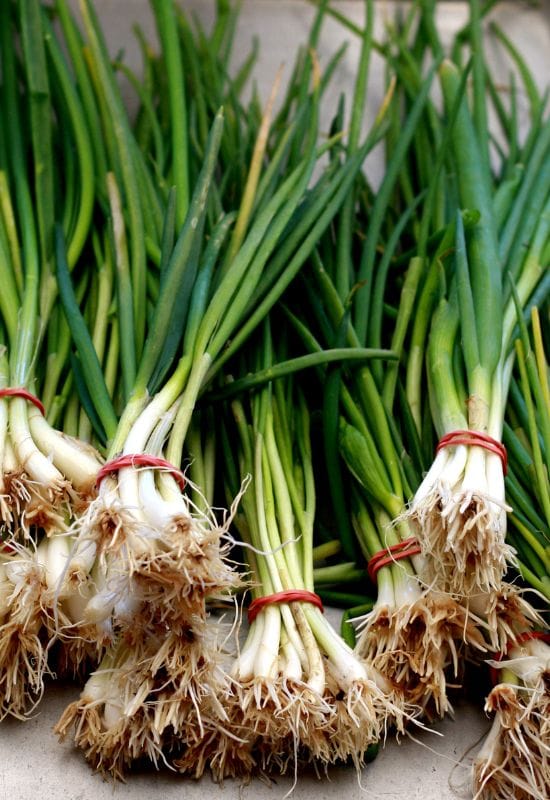
Benefit: Pest Repellent
Just like bulb onions, the strong scent of scallions, or green onions, will also repel unwanted insects.
How To Grow As A Companion: These tall slender plants can mature quite quickly (50 to 70 days to maturity) and the slender stalks do not take up as much space as the bulb varieties so they can be interplanted amongst the strawberries.
5: Garlic

Benefit: Pest Repellent
No one likes garlic breath, and most people agree that garlic can be stinky. Many creatures agree, and the natural oils and sulfur compounds of garlic are a natural pesticide.
Garlic is good at repelling many unwanted bugs including strawberry spider mites, aphids, beetles, slugs, caterpillars, and there is also some evidence it can be effective at keeping away deer, rabbits, gophers, and other animals.
How To Grow As A Companion: Leave about 15cm (6 inches) between each clove and strawberry plant so they do not crowd each other while growing. Start garlic in the fall to let it overwinter so it will take off in the early spring. It takes about 8 to 10 months to mature so it will grow nicely alongside your strawberries all summer long.
6: Beets

Benefits: Loosen Soil and Intercropping
Beets are a great crop for companion planting with strawberries as they loosen the soil and provide two crops (the beetroot and the very healthy tops).
How To Grow As A Companion: Some beets can grow very large, so space them about 30cm (12 inches) from your strawberries. They can be harvested as baby beets, or full-sized depending on your garden space and cooking preference.
7: Radish
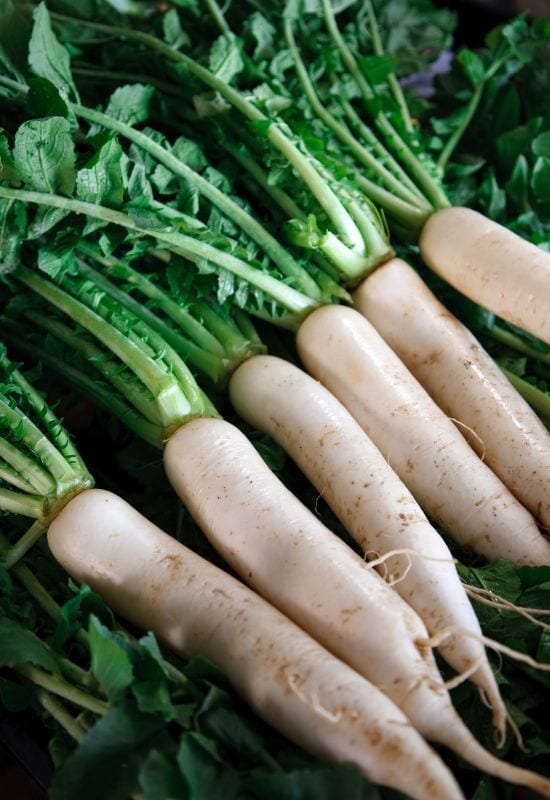
Benefits: Intercropping and Pollination
Radishes are one of the fastest growing vegetables to cultivate, and you can often grow two crops in the same area each year. So, interplanted with your strawberries, you will have three crops in the space of one.
Or, you can leave radishes to mature and they will produce clusters of pretty flowers that bees and hummingbirds love, as well as edible seed pods.
How To Grow As A Companion: Plant a row of radishes about 15cm (6 inches) from your strawberries to make sure they both have enough space to grow. Harvest when they are mature to avoid them becoming tough and woody.
If you are leaving radishes to mature, plant them at least 30cm (12 inches) from your strawberries as the radish plants grow quite large.
8: Asparagus

Benefits: Perennial Intercropping
Asparagus to not directly benefit strawberries, but they do not compete with strawberries in any way making them an ideal pairing for maximizing yields. Asparagus roots go deep around the strawberries’ shallow ones, and they are usually harvested well before the strawberries need the nutrients.
How To Grow As A Companion: Strawberries and asparagus can be grown in the same rows, or beside one another. Remember that a well-tended asparagus bed can be productive for over 20 years, so make sure you plan the bed carefully.
9: Rhubarb

Benefit: Pest Repellent and Shade
Rhubarb is sour and many creatures that invade the garden find it that way, too. It repels many insects, and deer and other furry animals will walk right by it. With luck, they won’t stop to see if there are strawberries underneath the large leaves. They can also provide shade during the hot summer.
How To Grow As A Companion: Rhubarb is best grown from crowns. Space rhubarb at plants about 1m (3 feet) apart. However, if you plan on letting the plants grow so they are more of an obstacle for animals, make sure you space them farther as one plant can grow extremely large.
10: Lettuce

Benefit: Intercropping
While lettuce doesn’t directly provide any benefit to the berries themselves, it is a great plant to tuck in between your strawberry plants to maximize space and improve yield of the area.
How To Grow As A Companion: Sow lettuce seeds according to package instructions between your strawberries. It can be grown in rows or scattered amongst the crowns to make the most of the space. Be careful not to overwater as this can attract slugs and other unwanted pests.
11: Spinach

Benefit: Intercropping
Just like lettuce, spinach will grow beside strawberries and give you a second (and possibly a third) harvest from your strawberry patch.
How To Grow As A Companion: Sow spinach seeds early in the spring or the fall after the heat of summer has passed. This way, you can harvest the spinach before your strawberries even flower and again after they have stopped flowering for the season.
12: Purslane

Benefit: Weed Suppression
It can be challenging to weed between strawberries, so why not grow an edible ground cover? Purslane spread quickly and chokes out weeds, so keep it under control and it will fill in the area around your strawberries. It is also healthy and grows well in the hot summer months. Purslane has also been shown to improve the yields of strawberry plants.
How To Grow As A Companion: Sow thickly to let the leaves grow in. Cut the plant back when it has matured, or pick off individual leaves as desired. Do not let it go to seed or it will reseed itself with thousands of seeds (which is why many gardeners consider it an invasive weed.
Herb Companion Plants For Strawberries
Herbs are not only good in the kitchen, but they play a vital role in the garden and provide numerous benefits for your strawberries:
13: Basil

Benefits: Pest Repellent & Growth Promoter
Basil is a versatile plant in the kitchen and the garden. Planting basil directly next to strawberries can improve plant vigor and repel pests. Basil’s strong scent can help to deter some pests that might otherwise attack strawberry plants, such as aphids and spider mites.
If left to bolt the flowers will attract pollinators and predatory bugs, but this is a waste of a perfectly delightful herb.
Tulsi, or holy basil, is a good variety that you can use medicinally or as an herbal tea.
Overall planting basil and strawberries together can be a great way to maximize the use of space in your garden and create a mutually beneficial growing environment.
How To Grow As A Companion: Basil can be grown quite compactly if you wish to sprinkle the seeds around your strawberries. Otherwise, growth is the herb in rows beside the patch. You can also take cuttings from your plant to cultivate more basil.
14: Mint

Benefits: Pest Repellent
The strong aroma of mint will deter many different types of insects, as well as ground squirrels, gophers, and other rodents, plus deer and other ungulates.
Mint can, however, attract tarnished plant bugs which can be a problem for your strawberries if your garden is prone to them. Lemon balm is a nice variety that gives a nice new lemony flavor.
How To Grow As A Companion: Mint can be grown directly in the garden, but the tendency of most varieties to spread can make it a chore to keep contained. Consider growing mint in pots that you can strategically position around your strawberries as needed. We often set the pots directly on top of mouse and rodent holes to chase them away with fairly good success.
15: Chives

Benefit: Pest Repellent
Chives are an excellent perennial version of the onions family which insects and animals including aphids, flies, beetles, rabbits, squirrels, gophers, and even deer do not like. Chives are listed as Zone 3 but we easily grow them in our Zone 2b garden.
How To Grow As A Companion: Grow chives directly in the garden or a pot. Chives spread slowly, but if left to go to seed (the flowers are also edible and very spicy), they will prodigiously self-seed.
16: Dill

Benefits: Attracts Pollinators and Predatory Insects
Dill is a beautiful umbellifer that produces large umbrella-shaped flowers. The tall yellow flowers will be swarming with all the good bugs you want around your strawberries such as bees, praying mantis, ladybugs, and wasps (yes, they are an excellent predator).
How To Grow As A Companion: The tall, slender plants can be easily direct sown amongst your strawberries, or grown in rows beside. Dill is a fairly easy plant to grow and requires little maintenance.
17: Cilantro & Coriander
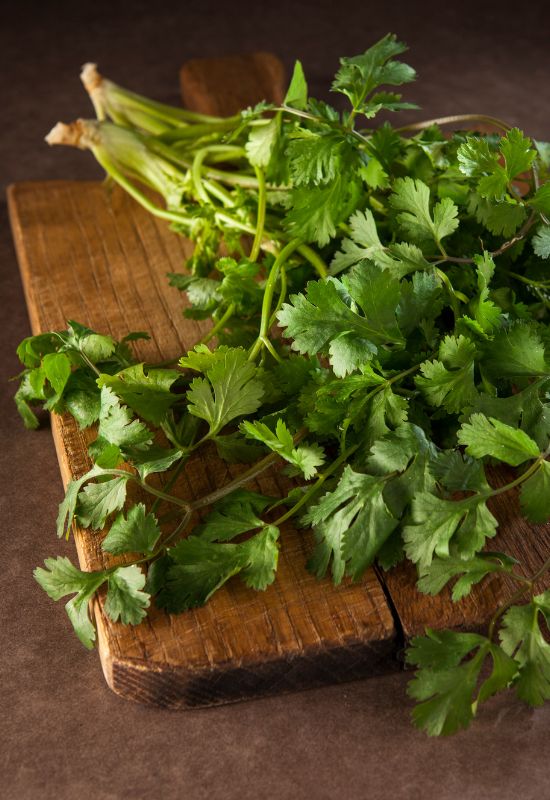
Benefits: Pest Repellent & Attracts Pollinators and Predatory Insects
Cilantro and coriander are the same herb, the former is the fresh leaves while the latter is the seeds. The aromatic leaves repel insects while the flowers (umbellifer-like dill) will attract lots of good bugs.
How To Grow As A Companion: Cilantro can be a tricky plant to grow, but if your climate is right it can make a great companion plant in rows beside your strawberries.
18: Thyme

Benefits: Pest Repellent, Attracts Pollinators and Predatory Insects, & Ground Cover
Thyme is a great herb that can be eaten, repels pests, and attracts lots of good bugs when it starts flowering. Certain varieties also grow as a ground cover that will act as a living mulch.
How To Grow As A Companion Plant: Time can be grown in rows beside or right under your strawberries. In some zones, thyme can be grown as a perennial
19: Catnip
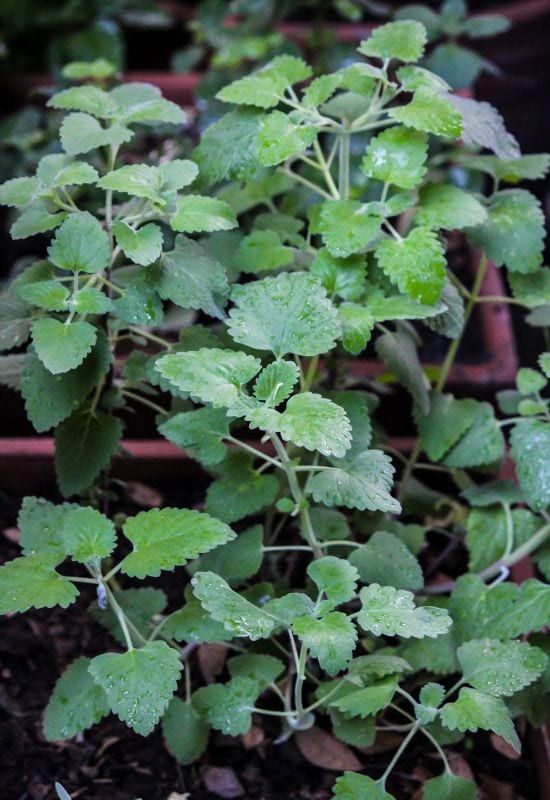
Benefits: Attracts Pollinators and Predatory Insects
Catnip not only attracts cats to your garden but many good bugs once it flowers.
How To Grow As A Companion Plant: Catnip can be quite invasive, so plant carefully and keep an eye on it to mitigate spreading. Alternatively, you can grow it in pots and put them in your strawberry patch, or bury a pot at soil level to control the spreading roots.
20: Sage

Benefits: Attracts Pollinators and Predatory Insects, & Improves Flavor
Sage has truly beautiful flowers, and many gardeners have found that sage improves the flavors of strawberries growing nearby. While there is no real science to back this up, the best and most natural parts of gardening rarely are.
How To Grow As A Companion: Sage plants can grow quite large, so make sure they are about 60cm (2 feet) from your strawberries. In zone 5 plus climates, sage can be grown as a perennial.
21: Caraway
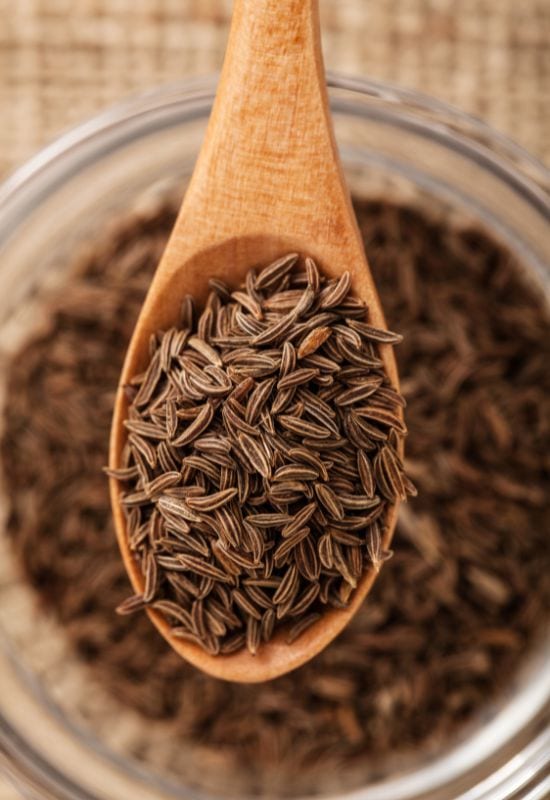
Benefits: Attracts Pollinators and Predatory Insects
A relative of parsley, caraway also produces umbrella-shaped flowers that attract good insects. Bear in mind that carraway is a biennial so will not flower the first year. It is hardy to Zone 4, so if you live in a colder climate, you might not have success with flowering.
How To Grow As A Companion: The plants can become quite large, so make sure they are about 60cm (2 feet) from the strawberries so they both have room to grow. Because they are a biennial, make sure your plan where you grow them as they will be there for a while.
Floral Companion Plants For Strawberries
Many people have a hard time growing flowers in their productive gardens, and I must confess that I used to be this way myself. However, the benefits of having flowers in our fruit and vegetable gardens go far beyond aesthetics.
These flowers are great companion plants for strawberries.
22: Sunflowers

Benefits: Attracts Pollinators and Predatory Insects
Many people say sunflowers should not be grown with strawberries because they will cast too much shade, but this can be easily avoided by careful planting. Besides, the dozens of good bugs that swarm to a single sunflower at one time will do far more for your strawberries than a few hours of shade each day.
Make sure you grow sunflowers with an early maturing, June-bearing strawberry so all your precious berries have been harvested before the hungry birds come for the sunflower seeds.
How To Grow As A Companion: Plant sunflowers as early as you can in your climate so they have enough time to mature and ripen. Space your sunflowers 30cm to 45cm (12-18 inches) apart depending on the variety, and plant them on the north or west side of your strawberries to avoid overshadowing the berries.
questionable excellent pollinators but planted in the wrong spot will provide too much shade.
23: Alyssum
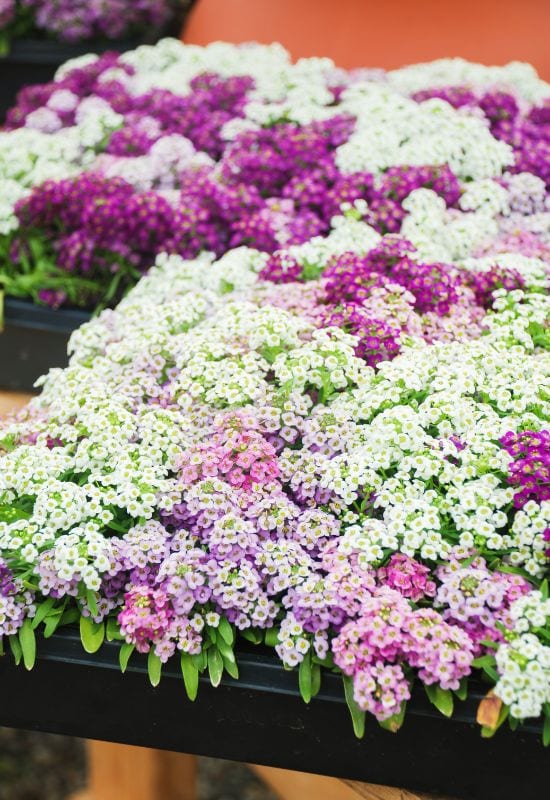
Benefits: Attracts Pollinators and Predatory Insects
This dense carpet of flowers will draw countless pollinators and other good bugs to your strawberries. It is a great living mulch and green manure crop, depending on your needs, and the white or purple flowers will bloom from late spring right through to the fall.
How To Grow As A Companion: Alyssum can be grown as a border around your strawberries, or undersown for a ground cover.
24: Clover

Benefits: Attracts Pollinators and Predatory Insects, & Nitrogen Fixation
Another great groundcover for strawberries, clover is an incredibly hardy plant that attracts pollinators and hunting bugs. Since it is a legume, it fixes nitrogen into the soil like beans and peas.
There are annuals and perennials available depending on the long term goals of your clover, though the annuals will consistently reseed themselves if left to mature.
How To Grow As A Companion: Sow clover around your strawberries as a living mulch (though you may want to keep it trimmed as it can become quite aggressive when it is large), or grow it as a boarder plant to attract good bugs. It can also be tilled under with your strawberries as part of your berry patch regeneration plan.
25: Marigolds

Benefits: Repel Nematodes, & Protect From Hungry Animals
Marigold’s strong musky smell overpowers the sweet smell of strawberries so that hungry animals will pass right by. They also repel a large number of bad bugs.
Marigolds also protect the roots of the strawberries by repelling harmful nematodes (bad soil dwelling worms) that destroy the root of plants. French marigolds, in particular, are very effective at ridding the soil of root knot nematodes.
How To Grow As A Companion: Marigolds can be a variety of different sizes, but they work well planted as a border to your strawberries. In a large berry patch, plant a marigold every meter or so (3 feet) along your strawberry rows.
26: Borage

Benefits: Attracts Pollinators and Predatory Insects, Improve Berry Flavor, Resist Disease Borage is actually a Mediterranean herb with medicinal qualities, but most people grow it as a flower so it is included in the floral companion plants.
Borage can provide a number of good benefits for your strawberries. First, the unique blossoms attract pollinators and hungry predator bugs, plus it helps strawberries fight off certain diseases.
Many gardeners also claim that borage makes strawberries taste sweeter. One reason for this is that borage is known to draw nutrients from deep down with its penetrating tap root where the shallow-rooted strawberries can then access them and grow better.
As extra bonuses, the leaves and flowers are edible, and borage has been found to be deer resistant so maybe it will help protect your strawberries, too.
How To Grow As A Companion: Under the right conditions, a borage plant will grow 60cm (2 feet) tall and 30cm (1 foot) wide, so make sure you plant them far enough away that they won’t crowd the strawberries. Direct sow the seeds in the spring so the plant has time to mature and bloom.
27: Yarrow

Benefits: Attracts Pollinators and Predatory Insects
Yarrow is a hardy plant that grows wild in a lot of climates. We see yarrow popping up all over our Zone 2b farm, and we never pull it out because of its beneficial qualities.
Good bugs love yarrow, in particular hoverflies, which are both pollinators and predators (they are voracious feeders of aphids). They typically come in yellow and white flowers and both are great for the strawberries.
It can also be used in herbal remedies when your strawberries are done producing.
How To Grow As A Companion: Yarrow can grow to be very large, over 1 meter (3 feet) tall, with a decent spread, so position your yarrow so they won’t block too much sun, and so they are 30cm to 60cm (1-2 feet) from each other and your strawberries.
They are often started indoors and transplanted outside, but they can be direct sown in well prepared beds.
28: Lupins
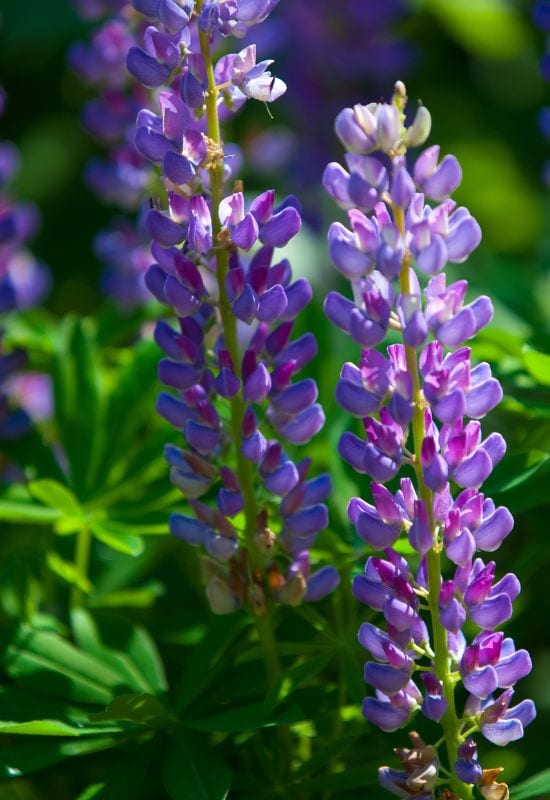
Benefits: Nitrogen Fixation, & Attracts Pollinators and Predatory Insects
Like other legumes, lupins promote the development of nitrogen-fixing bacteria which infect their roots and add nitrogen to the soil.
The towers of beautiful flowers are a great beneficial insect attractant, but remember that lupins are toxic to people and animals so plant judiciously if children and pets frequent your strawberry patch.
How To Grow As A Companion: Lupins can grow up to 1 meter (3 feet) tall, and usually work better as a border planting to strawberries. They come in many colours so they can make a really attractive accent.
If interplanted with your strawberries, make sure to leave at least 30cm (1 foot) space between the plants so they don’t crowd the berries.
29: Nasturtium
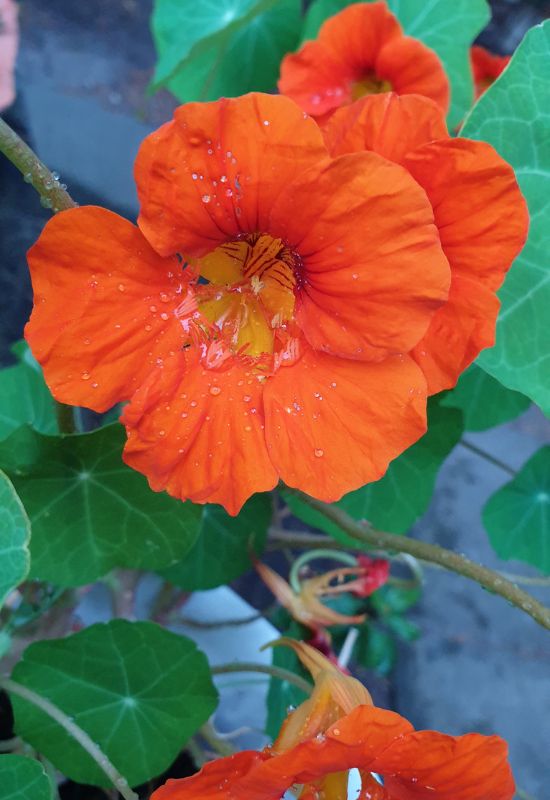
Benefits: Attracts Pollinators and Predatory Insects, & Pest Repellent
Nasturtiums attract lots of bugs, both good and bad. For example, aphids are drawn to these pretty little flowers (which keeps them away from your strawberries) and hoverflies also like nasturtiums which feed on the aphids.
As an added bonus, nasturtium flowers are edible and make a nice addition to summer salads, or an edible decoration to strawberries and ice cream.
How To Grow As A Companion: Nasturtiums are generally either bushy or vining, and both can grow to impressive sizes. They are best grown on the side of your strawberries and create a nice vertical backdrop to your crawling strawberries
30: Phacelia
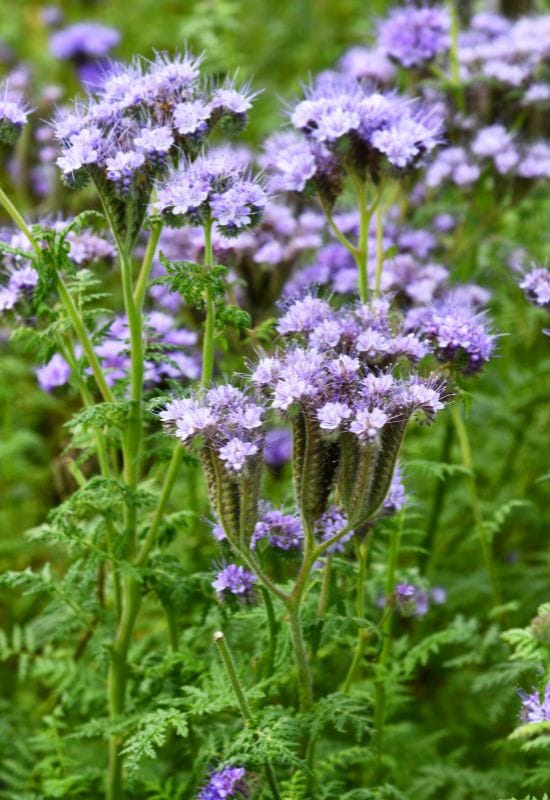
Benefits: Attracts Pollinators, & Soil Health
Phacelia are an ornamental flower in the borage family. They are becoming increasingly popular in organic agriculture as a pollinator and cover crop that improves soil health.
Phacelia are one of the chief plants for honey bee production, and they will attract drones of pollinators and other beneficial insects to your strawberries.
Phacelia have also been found to help balance good and bad nematodes in the soil by attracting beneficial ones and warding off bad nematodes and their roots add copious amounts of organic matter. Also, its abundance of plant matter creates a winter-kill cover crop around your strawberries.
How To Grow As A Companion: Phacelia can grow very large so they are usually best planted outside your strawberry patch but still close enough that the strawberries will still benefit from the companion.
What NOT To Plant With Strawberries
Just as there are good plants that help your strawberries, there are also bad plants that will hinder your strawberries.
Here are some plants to avoid near your strawberries:
Conclusion
Nature is a wonderful and diverse system that people only have a vague understanding of. While the science-based agriculture community is starting to “prove” the benefits of companion planting,
the benefits of growing two or more beneficial species together have been known since humankind first put seeds in the ground. Many of the values of companion planting are old wives tales, or based on the gardener’s personal experience, and this is usually of far more value than the statistics that come from a laboratory.
I hope companion planting brings you as many benefits, and pleasures, as it has to countless other avid gardeners.

Written By
Margie Fetchik
Margie and Arkansas native has an extensive background in gardening and landscaping. For the last 40 years, Margie has called the Colorado Rocky Mountains her home. Here she and her husband of 36 years raised three kids and owned a successful landscaping company. Margie has a CSU Master Gardener certification. She specialized in garden design & installation, perennial gardens, turf grasses & weeds, flower containers, and the overall maintenance of allHOA, commercial and residential accounts. She and her husband now reside in Denver and are excited about the new experiences’ city life holds.
